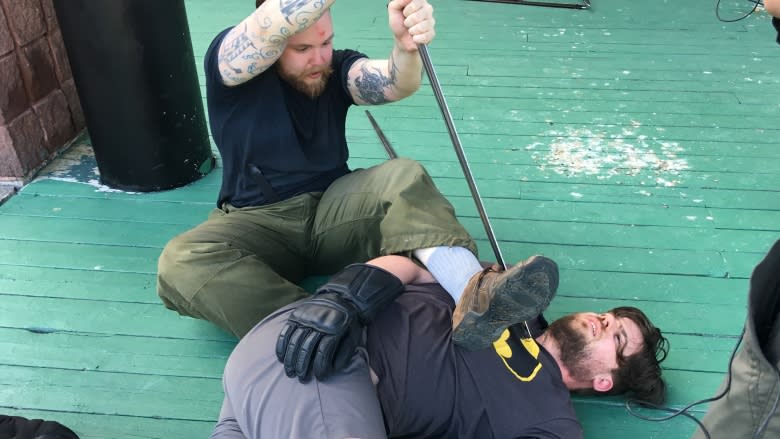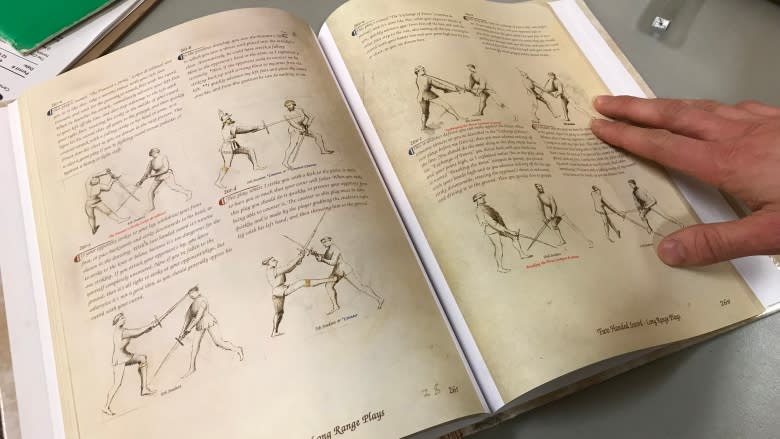Blood, fire and lethal metal: Medieval sword fighting, in Bowring Park
In the shadow of a St. John's amphitheatre — and on the shoulders of history's most brutal warriors — the clashing of swords rings out.
The Newfoundland Western Martial Arts community meet here to practise "historical European martial arts": an organized — albeit scattered — global revival of the skills once wielded by knights and mercenaries in the Dark Ages.
Over the last few years, clubs have popped up across the country.
Here in Bowring Park, these knights-in-training convene once a week to master footwork, trade strategies and debate the correct interpretation of the few surviving texts on swordsmanship.
Much of what they know was written by knights and soldiers in the 14th and 15th centuries — warriors who didn't exactly use those techniques for leisure.
"We try not to get killed," says Adam Murrin, the group's co-founder.
Aside from the occasional injury — a twisted knee or bloody knuckle when the opponent's solid-metal longsword glances off a blade — Murrin insists they try to play it safe.
But that's a problem for an art form intended, by design, to maim and kill.
"A lot of the feeling disappears if you dumb it down to too safe," Murrin said. "But then if you go too rough, you end up hurting people."
In the background, two trainees wrestle to the ground, sword nearly finding jugular. One of them has opened a wound on his forehead.
"That's refreshing," the bleeding victor says, picking himself up.
"A bit of historical experimentation."
Archeology in action
This particular group follows the remaining medieval texts — a sometimes confusing medley of poetry, instructions and sketches — as closely as possible.
They see the art form as a kind of "experimental archeology," says co-founder Lee Gillis, a way to better understand the logic behind the lifestyles of their ancestors.
"Immersing yourself in that history is central to understanding it better," Gillis said.
"It's the same reason you'd go to L'Anse aux Meadows and see people dressed up."
Murrin agrees. "It's a shame, most of the living lineages died out in World War I and II in favour of guns," he said. "But by sparring we can get a much better sense of the actual martial art. So this has a real historical importance."
Forging a new view of history
Gillis takes the experimentation a step beyond sword fighting. A trained welder, he hammers out his own weapons in a homemade forge.
He stokes the flames using a leaf blower he's rigged to the underside of an old iron tire well.
"I'm getting the fire nice and hot so I can heat the knife appropriately without melting it," he said in an interview. "Once it's nice in colour, either a cherry red or just above that … I'll pull it out of the fire and put it on the anvil."
Gillis, an undergraduate in medieval history at Memorial University, is crafting a bevelled dagger he saw in one of his textbooks. "This one is in the Tower of London," he said.
Attention to detail, Gillis says, means he gets inside the skin of those he studies, accruing knowledge a history book could never impart.
"I'm trying to bring the past to life. I'll never be a medieval blacksmith, but I can get close. I can understand the conditions I'm working with, say the heat of the forge they're working with. Maybe that would explain the way they're dressed."
Gillis hopes future generations will learn from us in the same way.
"I we can look back and see where we came from, we can learn something. We can see something we forgot, something that fell by the wayside, something that still has applicable value.
"The past happened and what people did happened," he said. "It mattered to them. And, I think, to us."
Read more from CBC Newfoundland and Labrador






